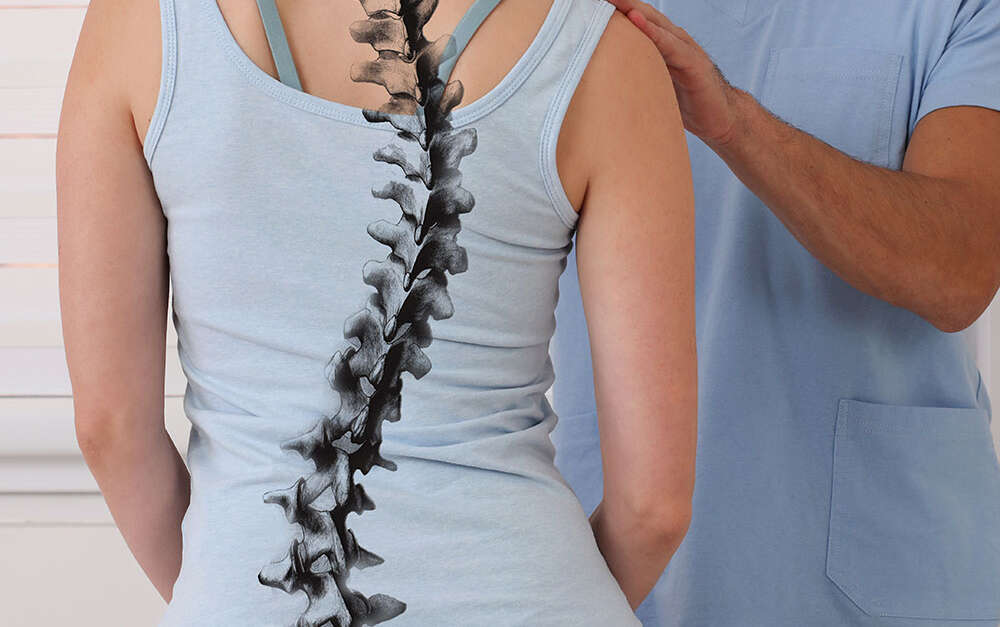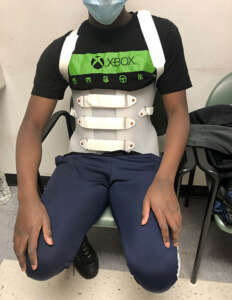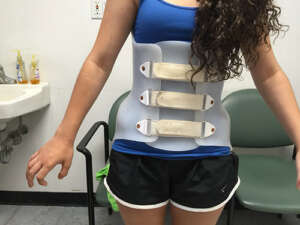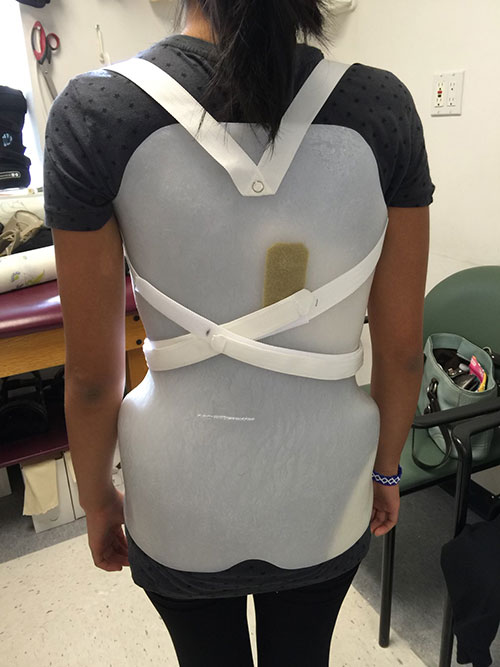
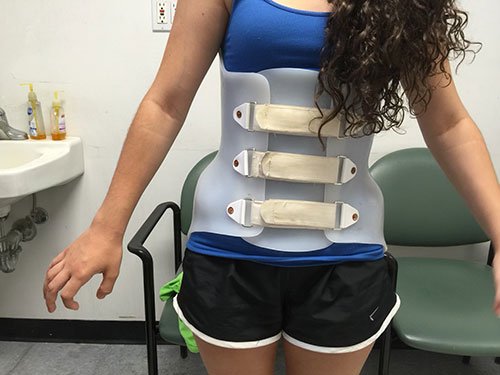
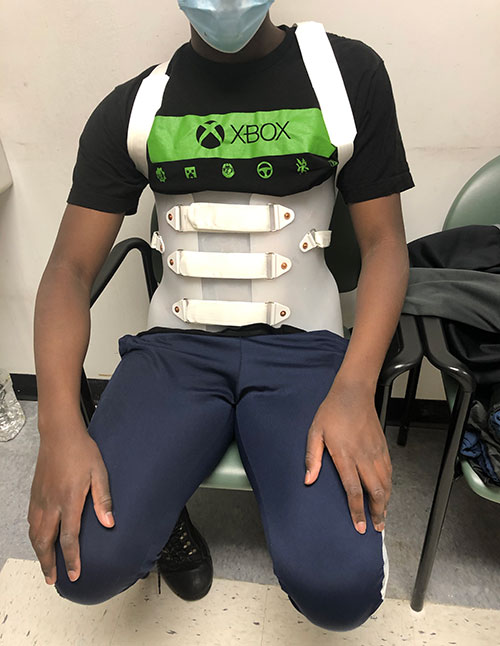
Our scoliosis brace is custom molded to patient model from a casting of the patient’s torso.
N.B.B. Orthotics, Inc. specializes in scoliosis bracing.
Frequently Asked Questions About Scoliosis
This fact sheet defines scoliosis and provides information about how it is diagnosed and treated in children and adolescents. You may be interested in contacting one or more of the organizations referenced at the end of the fact sheet for more information.
Scoliosis is a sideways curvature of the spine, or backbone. The bones that make up the spine are called vertebrae. Some people who have scoliosis require treatment. Other people, who have milder curves, may only need to visit their doctor for periodic observation. The section “Does Scoliosis Have To Be Treated?” describes how doctors decide whether or not to treat scoliosis.
Who Gets Scoliosis?
People of all ages can have scoliosis, but this fact sheet focuses on children and adolescents. Of every 1,000 children, 3 to 5 develop spinal curves that are considered large enough to need treatment. Adolescent idiopathic scoliosis (scoliosis of unknown cause) is the most common type and occurs after the age of 10. Girls are more likely than boys to have this type of scoliosis.
Since scoliosis can run in families, a child who has a parent, brother, or sister with idiopathic scoliosis should be checked regularly for scoliosis by the family physician.
Idiopathic scoliosis can also occur in children younger than 10 years of age, but is very rare. Early onset or infantile idiopathic scoliosis occurs in children less than 3 years old. It is more common in Europe than in the United States. Juvenile idiopathic scoliosis occurs in children between the ages of 3 and 10.
What Causes Scoliosis?
In 80 to 85 percent of people, the cause of scoliosis is unknown; this is called idiopathic scoliosis. Before concluding that a person has idiopathic scoliosis, the doctor looks for other possible causes, such as injury or infection. Causes of curves are classified as either non structural or structural.
-
Non Structural (functional) scoliosis: A structurally normal spine that appears curved. This is a temporary, changing curve. It is caused by an underlying condition such as a difference in leg length, muscle spasms, or inflammatory conditions such as appendicitis. Doctors treat this type of scoliosis by correcting the underlying problem.
-
Structural scoliosis: A fixed curve that doctors treat case by case. Sometimes structural scoliosis is one part of a syndrome or disease, such as Marfan’s syndrome, an inherited connective tissue disorder. In other cases it occurs by itself. Structural scoliosis can be caused by neuromuscular diseases (such as cerebral palsy, poliomyelitis, or muscular dystrophy), birth defects (such as hemivertebra, in which one side of a vertebra fails to form normally before birth), injury, certain infections, tumors (such as those caused by neurofibromatosis, a birth defect sometimes associated with benign tumors on the spinal column), metabolic diseases, connective tissue disorders, rheumatic diseases, or unknown factors (idiopathic scoliosis).
How Does the Doctor Diagnose Scoliosis?
The doctor takes the following steps to evaluate a patient for scoliosis:
-
Medical history: The doctor talks to the patient and the patient’s parent or parents and reviews the patient’s records to look for medical problems that might be causing the spine to curve; for example, birth defects, trauma, or other disorders that can be associated with scoliosis.
-
Physical examination: The doctor looks at the patient’s back, chest, pelvis, legs, feet, and skin. The doctor checks if the patient’s shoulders are level, whether the head is centered, and whether opposite sides of the body look level. The doctor also examines the back muscles while the patient is bending forward to see if one side of the rib cage is higher than the other. If there is a significant asymmetry (difference between opposite sides of the body), the doctor will refer the patient to an orthopedic spine specialist (a doctor who has experience treating people with scoliosis). Certain changes in the skin, such as so-called cafe au lait spots, can suggest that the scoliosis is caused by a birth defect.
-
X-ray evaluation: Patients with significant spinal curves, unusual back pain, or signs of involvement of the central nervous system (brain and spinal cord) such as bowel and bladder control problems need to have an X ray. The X ray should be done with the patient standing with his or her back to the x-ray machine. The view is of the entire spine on one long (36-inch) film. Occasionally, doctors ask for more tests to see if there are other problems.
-
Curve measurement: The doctor measures the curve on the x-ray image. He or she finds the vertebrae at the beginning and end of the curve and measures the angle of the curve. Curves that are greater than 20 degrees require treatment.
Doctors group curves of the spine by their location, shape, pattern, and cause. They use this information to decide how best to treat the scoliosis.
-
Location: To identify a curve’s location, doctors find the apex of the curve (the vertebra within the curve that is the most off-center); the location of the apex is the “location” of the curve. A thoracic curve has its apex in the thoracic area (the part of the spine to which the ribs attach). A lumbar curve has its apex in the lower back. A thoracolumbar curve has its apex where the thoracic and lumbar vertebrae join.
-
Shape: The curve usually is S- or C-shaped.
- Pattern: Curves frequently follow patterns that have been studied in previous patients. The larger the curve is, the more likely it will progress (depending on the amount of growth remaining).
What Are the Treatments For Scoliosis?
The doctor will suggest the best treatment for each patient based on the patient’s age, how much more he or she is likely to grow, the degree and pattern of the curve, and the type of scoliosis. The doctor may recommend observation, bracing, or surgery.
-
Observation: Doctors follow patients without treatment and re-examine them every 4 to 6 months when the patient is still growing (is skeletally immature) and has an idiopathic curve of less than 25 degrees.
-
Bracing: Doctors advise patients to wear a brace to stop a curve from getting any worse when the patient:
-
-
is still growing and has an idiopathic curve that is more than 25 to 30 degrees;
-
has at least 2 years of growth remaining, has an idiopathic curve that is between 20 and 29 degrees, and, if a girl, has not had her first menstrual period; or
-
is still growing and has an idiopathic curve between 20 and 29 degrees that is getting worse.
-
-
As a child nears the end of growth, the indications for bracing will depend on how the curve affects the child’s appearance, whether the curve is getting worse, and the size of the curve.
-
Surgery: Doctors advise patients to have surgery to correct a curve or stop it from worsening when the patient is still growing, has a curve that is more than 45 degrees, and has a curve that is getting worse.
Are There Other Ways To Treat Scoliosis?
Some people have tried other ways to treat scoliosis, including manipulation by a chiropractor, electrical stimulation, dietary supplements, and corrective exercises. So far, these treatments have not been scientifically proven to be effective.
Can People with Scoliosis Exercise?
Exercise does not make scoliosis worse. In fact, it is very important for all people, including those with scoliosis, to exercise and remain physically fit. Girls have a higher risk than boys of developing osteoporosis (a disorder that results in weak bones that can break easily) later in life. The risk of osteoporosis is reduced in women who exercise regularly all their lives; and weight-bearing exercise, such as walking, running, soccer, and gymnastics, increases bone density and helps prevent osteoporosis. For both boys and girls, exercising and participating in sports also improves their general sense of well being.
Why Do You Have to Treat Scoliosis If It is hardly Noticeable And I don’t Have Any Pain?
It is treated to prevent your curve from getting worse. Without treatment, your curve could become so severe that you might have obvious physical deformity, back pain, and in certain cases, heart and lung problems.
What Are Researchers Trying To Find Out About Scoliosis?
Researchers are looking for the cause of idiopathic scoliosis. They have studied genetics, growth, structural and biochemical alterations in the discs and muscles, and central nervous system changes. The changes in the discs and muscles seem to be a result of scoliosis and not the cause. Scientists are still hopeful that studying changes in the central nervous system in people with idiopathic scoliosis may reveal a cause of this disorder.
Where Can People Get More Information About Scoliosis?
- National Scoliosis Foundation
5 Cabot Place
Stoughton, MA 02072
(617) 341-6333
(800) NSF-MYBACK (673-6922)
Fax: (617) 341-8333
E-mail: Scoliosis@aol.com
This is a nonprofit voluntary organization that provides pamphlets, a newsletter, and other information materials on childhood and adult scoliosis. The foundation also provides support group information and lists of physicians in each State who specialize in scoliosis.
- The Scoliosis Association, Inc.
P.O. Box 811705
Boca Raton, FL 33481-1705
(800) 800-0669
(561) 994-4435
Fax: (561) 994-2455
This association publishes a quarterly newsletter and pamphlets. A single copy of their fact sheet is available free with a self-addressed, stamped envelope. The association also provides information about local chapters and support groups.
- The Scoliosis Research Society
6300 North River Road
Suite 727
Rosemont, IL 60018-4226
(847) 698-1627
Fax: (847) 823-0536
E-mail: Goulding@aaos.org
The society is a professional organization for orthopaedic surgeons interested in scoliosis. It provides pamphlets about the diagnosis and treatment of scoliosis. Price information for ordering pamphlets is available from the society. The society also can provide referrals to physicians.
- American Physical Therapy Association
Scoliosis
P.O. Box 37257
Washington, DC 20013
To obtain a copy of the American Physical Therapy Association’s brochure about scoliosis, please send a self-addressed, stamped envelope to the above address.

